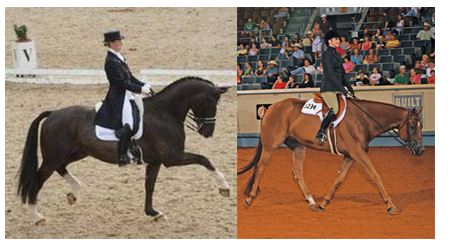How conformation and tack can affect your horse’s performance
"When purchasing a horse, it’s fair to say that most buyers want to purchase a horse breed to do the event of their choice. For example if you are interested in horse racing then you would tend to purchase a Thoroughbred or Quarter Horse (that’s specifically “race bredâ€) or if you are into cattle events then you may purchase a horse that has bloodlines from award winning cutting horses. How a horse is built can affect how well the horse can perform its job at hand. If you are interested in cutting then choosing a tall, lanky horse like a Thoroughbred may not be the wisest decision. That’s not to say other breeds cannot excel or perform in events they were not bred for but one should take into account the physical demand of the event. How much strain physically placed on a horse’s limbs, joints, soft tissue, long and short bones will depend on the demands of the event. Performance is often compromised when horses experience pain associated with their job. A study in Germany demonstrated that dressage horses with a more horizontal shoulder and vertical pelvis showed the greatest ability to flex at the shoulder and elbow and in the hind hip and stifle (Figure 1). The build of a horse can affect how it will perform its job. Consider comparing the Dressage horse and hunter under saddle horse (Figure 2) and take into account the difference in how these horses look and move. Also, notice the difference in tack and its fit on the horse and rider. When purchasing or breeding horses the overall balance and structural correctness of the horse should be evaluated. Balance refers to how a horse is put together when divided into thirds. Each third of the horse from the poll to wither, wither to the top of the hip, and the length of the hip should ideally be equal in length. We can also evaluate balance by looking for a trapezoid. When looking at the angle of the horse’s shoulder, length of its back, angle of its hip and the length of the underline one should be able to picture a trapezoid. The angle of the horse’s shoulder and hip are indicative of how that horse will move or perform its job. A horse expected to run long distances will have a longer more laid back shoulder so the front limb can reach forward with ease and cover the ground. The hind end of such horse will also have a long sloping angle so the hind limbs of the horse can reach forward and propel the horse forward. When comparing balance and overall conformation to a horse used for pleasure, or jumping, again one will see major differences in how the horse is built. When purchasing or breeding consider the purpose of the horse and what areas of the horse’s body may be at risk for potential injury. When breeding consider a stallion that can enhance or strengthen that area so its performance is not compromised due to injury incurred from poor balance and conformation. Another area to consider is how your tack fits your horse. It’s similar to shoe sizes in that we don’t all wear the same size shoe because we all have different size feet. It’s important to consider how your horse’s back is made when fitting saddles and even the padding used under your saddle. If your horse has a narrow back and high withers he may need a type of tree that’s more suitable for a horse with this conformation. The same is true when fitting a bit to your horse’s mouth. A pony will obviously require a much smaller mouthpiece compared to that of a warmblood. One area that should not be compromised when competing is the area of tack, but often times this is where corners are cut. Ill-fitting tack can lead to a painful experience with your horse and cause a decrease in performance. If your horse continues to experience pain associated with being ridden or shown due to ill-fitting tack then behavioral conditions may start to occur. Prior to purchasing tack for your horse consider consulting with those who make or sell tack to get help with properly fitting a bridle, bit and saddle to your specific horse. Overall, performance should not be inhibited by ill fitting tack or poor conformation!"

Figure 1 and 2. Consider the angle of this horse’s shoulder and hip in the first photo (dressage rider) compared to the Hunter under Saddle horse. Each horse move’s differently depending on how they are built and the job at hand. The tack that is being used in these photographs is also different. Notice the difference in the rider’s position in both photographs as well as their hand position connected to the reins. Amy McClean EQUINE LECTURER AND EQUINE EXTENSION SPECIALIST, NORTH CAROLINA STATE UNIVERSITY

